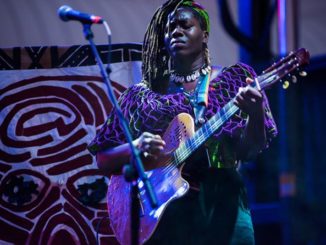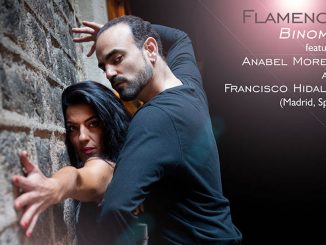 The Dance Now! Ensemble, celebrating its 10th anniversary season, presented in collaboration with the Bass Museum, its most recent site-specific work, “Ekphrasis: Art From Art.” Ekphrasis – a Greek term which co-director Diego Salterini enthusiastically described to me – is the process by which varying mediums of art react, define, describe, interpret and transform each other and ultimately inform new levels of appreciation for the audience. The term itself chosen purposely from the Greek language alludes to the forthcoming marriage of classic with modern, of the traditional with contemporary, and of the senses with sight, sound, and movement.
The Dance Now! Ensemble, celebrating its 10th anniversary season, presented in collaboration with the Bass Museum, its most recent site-specific work, “Ekphrasis: Art From Art.” Ekphrasis – a Greek term which co-director Diego Salterini enthusiastically described to me – is the process by which varying mediums of art react, define, describe, interpret and transform each other and ultimately inform new levels of appreciation for the audience. The term itself chosen purposely from the Greek language alludes to the forthcoming marriage of classic with modern, of the traditional with contemporary, and of the senses with sight, sound, and movement.
Co-director Hannah Baumgarten also emphasized this was not “a performance at the Bass Museum, but with the Bass Museum.” The distinction was evident in the four pieces that were presented at installations inside and on the grounds of the museum. The marriage of the performance pieces with the installations created such an intense symbiosis of visual and physical texture that you could have easily believed the curator always had it in mind to present the artwork with the dancers. As the program stated, this was a “migrating” performance and the company, in its selection of specific installations, did the museum justice by inviting us to all corners of this esteemed institution.
“Words that Soothe” begins the program on the 2nd floor in the claustrophobic confines of Jenny Holzer’s installation “Looming,” a three walled boxed room with stainless steel LED’s running horizontally from floor to ceiling across the back walls. The LED displays ran incrementally in size so that the full sentence displayed at the top of the wall was mirrored by only one or two words on the bottom. The sentences crossed at efficient speed in neon pink from right to left espousing Henri Cole’s poetry, “I’m sorry I cannot say I love you when you say you love me…” The three dancers, Todd Grace, Colleen Farnum, and Mikhail Niktine, were a modern Garcin, Inez, and Estelle from Sartre’s “No Exit,” running after each other; doomed to repeat the same chase and movements over and over again with no reward; and boxed in this neon colored purgatory. Like the poetry on the screens that ran its course and started again, the dance returned seamlessly to its beginning and continued what could be an eternal loop. The movement was frantic and belied an unease and frenetic anxiety of want without resolution. The dancers clasped at or leaned into each other, only to have the object of their embrace tear itself away, continuously running in infinite circles in this small room – at times alone, in duets, or the entire ensemble. In contrasting moments of stillness the dancers would individually or collectively as an echo, recite Henri Cole’s words almost in unison with the hot pink words as they danced by like a fourth member of the ensemble. As sterile as the steel and as hot as the lights the dancers vacillated between the cold and warm flux of the human condition in this cramped space whose narrow entrance dictated – from where you stood or sat – your own personal glimpse, experience and inner reflection. One of the unexpected yet welcome interactions of this art with the live performers came from a baby only months old sitting on the floor with her mother, cooing almost in response to Ms. Farnum’s recitation of Henri Cole’s words.
The active participation of the audience continued throughout the day as the ensemble “migrated” from one installation to the next. As patrons left Ms. Holzer’s installation to convene at the foot of the stairs on the first floor, they actively discussed the performance, interacted with the sculptural pieces that invited hands-on activity, and admired their surroundings. They slowly settled into rows of chairs or sat on the steps at the main foyer housing Dzine’s installation “The Love Below (Custom Speaker Box Chandelier).” The art piece was a chandelier covered in Swarovski crystals mounted below a plush red velvet crown with dangling light bulbs and wires as a sound system played a constant wave of non-descript undulating notes – distinct but as unobtrusive as a hum. The ostentatious, “Baroque beauty” of this modern day “bling” in a chandelier inspired the modern dance Las Meninas, the title for which brings to mind the 1656 painting of the same name by Diego Velazquez. The title literally translates to the “ladies in waiting” and the piece presents again Colleen Farnum as mistress to Lindsay Brown’s and Jessica Merritt’s maids. The ladies enter from white double doors at the opposite end of the foyer and from behind them there is a hazy light as the sun beams through white gauze. The ladies were costumed by Pauline Lawrence in a modern economic representation of the period dress with the classic low cut, tight bodices and wide French farthingales – the two maids were dressed identically and their mistress wore her own unique garment. The dance took place under the chandelier itself, as the mistress seemed almost to kneel in worship of it and tried to caress the hanging bulbs. Meanwhile a power play ensued as the maids in waiting went from recovering their fainting mistress to slowly usurping her central position. Like dolls in a music box, the three women danced as if performing the minuet underneath the light and sparkle of this unique ornament. As they stood in a row their farthingales impressively defined the horizontal space as much as the chandelier defined the vertical. The movements progressed from the understated, controlled and delicate to all out aggression as the maids moved in on their lady. The dancers gesticulated and spun while in the constraints of their bodices and farthingales. Their dresses sounded like a wind whipped tent as they swung their arms against the fabric and pitched forth on one leg releves and attitude, primping like Spanish bulls ready to strike. In the end the mistress is defeated and left crumpled on the floor into the folds of her garment. And the maids returned to their demure and polite demeanor and slowly curtsied to each other before the exeunt omnes.
The third piece titled “Venus and Adonis,” captured the movement so evident in Fedinand Bol’s painting of the same name. In the same warm red colored room where Bol’s painting was housed, there hung on three walls Dutch 17th century paintings and religious art by Jacob Jordaens, Peter Paul Rubens, Gerard Seghers, Ferdinand Bol, and Giovanni Barbagelata, as well as an altarpiece by Italian Renaissance masters Botticelli and Ghirlandaio. At the south side of the room a 16th century Flemish tapestry, “The Tournament,” covered the entire wall. At the foot of the tapestry rested a grand piano for the live Bach accompaniment played masterfully but with tender rendering by Hamilton Gutierrez. Bol’s imposing painting hung as a backdrop to a true Venus and Adonis come to life danced by co-director Hanna Baumgarten and Mikhail Niktine. In an echo of Bol’s Venus who tries to restrain Adonis from going off to the hunt, Baumgarten and Niktine intertwined their modestly dressed bodies as they performed effortless and unconventional lifts executed with great control and emotion. And each time they separated, their long lithe limbs reached for each other as they consumed the empty space between them. The setting of this room, the live music, the proximity of the dancers, and their embodiment of these renown historical lovers was so intimate that the audience was like a voyeur – wanting to allow these lovers their privacy but unable to look away from the scene. Ultimately, Venus’ attempts to keep Adonis were all in vain and every time Baumgarten would move towards Niktine and wrapped him, he always left until finally Adonis runs from the room itself leavi
ng a spent Baumgarten lying on the ground in Venus’ grief.
The final piece took place outdoors under the roofed columns of the plaza, enclosed by the reflecting pool. Tyrell V. Rolle joined the company’s performers Brown, Farnum, Grace, Merrit, and Niktine for this final ensemble piece. The dancers – some costumed in urban grey shirts, camouflage pants, grey knee high socks, and Converse sneakers -performed “Random Thoughts, Possible Ending” to a recorded mix including Husky Rescue and Nine Inch Nails. At the root of the choreographic structure by Mr. Salterini was the paradox of the open space of the outdoors and the obstructive pillars that constricted the space – whereas the dancers were limited to their performance area and then even the smaller dioramas created by the pillars, the plaza itself opened on three sides creating multiple vantage points from which the audience could view the work. This challenged the traditional proscenium setting of a concert stage and the audience moved about the area to watch the piece from the varying sides. As passersby, bicyclists, and even ballet students leaving their classes from the Miami City Ballet across the street stopped and joined the faithful audience, the dancers moved in and out of duets and triplets in their own microcosmic squares, frustratingly pushing against the pillars and themselves. As two dancers would move across the row of open spaces a third would join and pick up the energetic phrase just as one of the original two would leave – thus creating a seamless phrase that existed despite who joined or left. The dancers pushed against the hard concrete of the floor and pillars, flared in quick criss-crossings and scissor sharp battements, fought gravity in tense couplings and aggressive lifts and exploded as they flung themselves into each other. Ironically enough in this open space, the dancers never escape their confines and the piece ends appropriately enough with Farnum in a vertical dead lift above Todd Grace in plain sight unable to exit or move – an ending which in itself transformed the couple into a fleeting piece of sculpture.
Co-directors Baumgarten and Salterini set out to transform the audience’s experience of both the visual and performing art inspiring and informing the other, and succeeded in creating a lasting impression that enriched the experience of both art forms. Credit should be paid to the Bass Museum for inviting such a stimulating collaboration. And acknowledgement should be made of the dedication to the many site-specific works, of which this is the latest, that Dance Now! Ensemble has performed and collaborated on in its first ten years. This company is not only elegant and fierce, but is dedicated to its community. Over the course of ten years, the company has informed our beaches, landmarks, institutions, and public spaces and made themselves an artistic treasure in our community and a jewel in our own back yard. This latest presentation is but one more enriching, provoking, and well-crafted offering by a mature, exciting and bounds-breaking company.



Be the first to comment